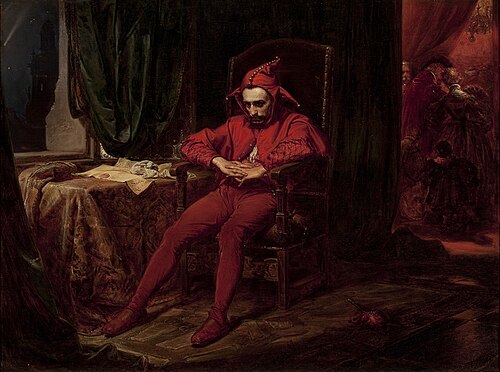Jesternoun
One who jests, jokes or mocks.
Jesternoun
A person in colourful garb and fool's cap who amused a medieval and early modern royal or noble court.
Jesternoun
A buffoon; a merry-andrew; a court fool.
Jesternoun
A person addicted to jesting, or to indulgence in light and amusing talk.
Jesternoun
a professional clown employed to entertain a king or nobleman in the middle ages
Jesternoun
a professional joker or ‘fool’ at a medieval court, typically wearing a cap with bells on it and carrying a mock sceptre.
Jesternoun
a person who habitually plays the fool.
Jester
A jester, court jester, or fool, was historically an entertainer during the medieval and Renaissance eras who was a member of the household of a nobleman or a monarch employed to entertain guests. Jesters were also itinerant performers who entertained common folk at fairs and town markets.
Harlequinnoun
A pantomime fool, typically dressed in checkered colorful clothes.
Harlequinnoun
A greenish-chartreuse color.
Harlequinnoun
(informal) A harlequin duck.
Harlequinnoun
(entomology) Any of various riodinid butterflies of the genera Taxila and Praetaxila.
Harlequinadjective
Brightly colored, especially in a pattern like that of a harlequin clown's clothes.
Harlequinadjective
Of a greenish-chartreuse color.
Harlequinverb
(transitive) To remove or conjure away, as if by a harlequin's trick.
Harlequinverb
(intransitive) To make sport by playing ludicrous tricks.
Harlequinnoun
A buffoon, dressed in party-colored clothes, who plays tricks, often without speaking, to divert the bystanders or an audience; a merry-andrew; originally, a droll rogue of Italian comedy.
Harlequinverb
To play the droll; to make sport by playing ludicrous tricks.
Harlequinverb
To remove or conjure away, as by a harlequin's trick.
Harlequinnoun
a clown or buffoon (after the Harlequin character in the commedia dell'arte)
Harlequinverb
variegate with spots or marks;
Harlequin
Harlequin (; Italian: Arlecchino [arlekˈkiːno]) is the best-known of the zanni or comic servant characters from the Italian commedia dell'arte. The role is traditionally believed to have been introduced by Zan Ganassa in the late 16th century, was definitively popularized by the Italian actor Tristano Martinelli in Paris in 1584–1585, and became a stock character after Martinelli's death in 1630.

















